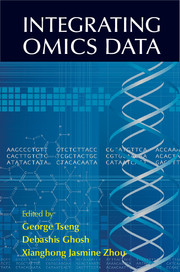Book contents
- Frontmatter
- Contents
- Contributors
- Introduction
- Part A Horizontal Meta-Analysis
- Part B Vertical Integrative Analysis (General Methods)
- Part C Vertical Integrative Analysis (Methods Specialized to Particular Data Types)
- 12 eQTL and Directed Graphical Model
- 13 MicroRNAs: Target Prediction and Involvement in Gene Regulatory Networks
- 14 Integration of Cancer Omics Data into a Whole-Cell Pathway Model for Patient-Specific Interpretation
- 15 Analyzing Combinations of Somatic Mutations in Cancer Genomes
- 16 A Mass-Action-Based Model for Gene Expression Regulation in Dynamic Systems
- 17 From Transcription Factor Binding and Histone Modification to Gene Expression: Integrative Quantitative Models
- 18 Data Integration on Noncoding RNA Studies
- 19 Drug-Pathway Association Analysis: Integration of High-Dimensional Transcriptional and Drug Sensitivity Profile
- Index
- Color plates
19 - Drug-Pathway Association Analysis: Integration of High-Dimensional Transcriptional and Drug Sensitivity Profile
from Part C - Vertical Integrative Analysis (Methods Specialized to Particular Data Types)
Published online by Cambridge University Press: 05 September 2015
- Frontmatter
- Contents
- Contributors
- Introduction
- Part A Horizontal Meta-Analysis
- Part B Vertical Integrative Analysis (General Methods)
- Part C Vertical Integrative Analysis (Methods Specialized to Particular Data Types)
- 12 eQTL and Directed Graphical Model
- 13 MicroRNAs: Target Prediction and Involvement in Gene Regulatory Networks
- 14 Integration of Cancer Omics Data into a Whole-Cell Pathway Model for Patient-Specific Interpretation
- 15 Analyzing Combinations of Somatic Mutations in Cancer Genomes
- 16 A Mass-Action-Based Model for Gene Expression Regulation in Dynamic Systems
- 17 From Transcription Factor Binding and Histone Modification to Gene Expression: Integrative Quantitative Models
- 18 Data Integration on Noncoding RNA Studies
- 19 Drug-Pathway Association Analysis: Integration of High-Dimensional Transcriptional and Drug Sensitivity Profile
- Index
- Color plates
Summary
Abstract
Traditional drug discovery practices usually adopt the “one drug – one target” approach, which ignore the fact the disease occurrence is usually the result of an extremely complex combination of molecular events. Pathway-based approaches address this limitation by considering biological pathways as potential drug targets. A first step of pathwaybased drug discovery is to identify associations between drug candidates and biological pathways. This has been made possible by the availability of high-dimensional transcriptional and drug sensitivity profile data. In this chapter, we describe two statistical methods, “iFad” and “iPad”, which perform drug-pathway association analysis by integrating these two types high-dimensional data. We also demonstrate their utilities by applying them to the NCI-60 data set.
Introduction
Drug discovery is the process of identifying new candidate medications for diseases of interest. The common practice adopted by the pharmaceutical industry is to design maximally selective drug molecules to act on individual drug targets [11], which is usually referred to as the “one drug – one target” approach. This paradigm has indeed enjoyed some successes [27]. Yet, the last 15 years have witnessed a significant increase in the attrition rate of new candidate drugs due to their low efficacy and serious side effects [17, 29]. One fundamental reason for the decline in the productivity of the pharmaceutical industry may lie in the core philosophy of the “one drug – one target” approach [11]. Specifically, this philosophy ignores the fact that disease occurrence is usually the result of an extremely complex combination of molecular events [20] among certain sets of functionally related genes, usually referred to as “pathways”. Targeting an individual drug target may not provide sufficient interference to the whole disease-related pathway and therefore usually results in unsatisfactory efficacy. Moreover, it fails to consider the mechanism of a candidate drug at a systems level, making it extremely difficult to evaluate drug safety and toxicity in the early developmental stages [14]. Due to these limitations of the “one drug – one target” approach, a new concept of drug discovery – polypharmacology [6] – is emerging as a promising alternative for drug developments. Instead of targeting individual drug targets, polypharmacology seeks to design or find candidate drugs that interfere multiple molecular targets. For example, pathway-based drug discovery, which pursues candidate drugs that interfere the activity of a whole biological pathway, has become increasingly appealing.
- Type
- Chapter
- Information
- Integrating Omics Data , pp. 425 - 444Publisher: Cambridge University PressPrint publication year: 2015



